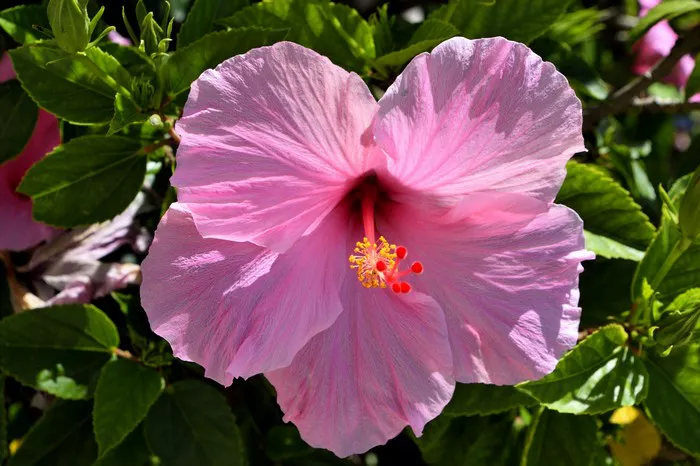The hibiscus flower, with its vibrant colors and delicate petals, is a symbol of beauty and grace found in gardens and landscapes around the world. In this comprehensive guide, we will delve into the captivating characteristics of the hibiscus flower, exploring its appearance, varieties, and cultural significance.
Introduction to the Hibiscus Flower
The hibiscus, belonging to the Malvaceae family, is a genus of flowering plants that encompass hundreds of species, ranging from small shrubs to towering trees. Among these species, the most commonly cultivated and admired is the Hibiscus rosa-sinensis, known for its large, showy blooms and ornamental appeal.
Appearance
The hibiscus flower is renowned for its striking appearance, characterized by several distinctive features:
1. Vibrant Colors: One of the most captivating aspects of the hibiscus flower is its vivid hues. These flowers can be found in a spectrum of colors, including shades of red, pink, yellow, orange, white, and even purple. Some varieties exhibit a single solid color, while others boast intricate patterns or contrasting hues, adding to their allure.
2. Petal Structure: The petals of the hibiscus flower are typically broad and overlapping, forming a conspicuous trumpet-like shape. Each flower typically consists of five petals, although some varieties may have more or fewer. The petals may be smooth or ruffled, depending on the specific cultivar.
3. Prominent Stamen and Pistil: At the center of the hibiscus flower, you’ll find a prominent reproductive structure comprised of stamens and pistils. The stamens, which produce pollen, surround the elongated pistil, the female reproductive organ responsible for seed production. These structures add both visual interest and functional significance to the flower.
4. Size and Shape: Hibiscus flowers vary in size, with diameters ranging from a few inches to over a foot across. The shape of the flower can also vary, from perfectly round to slightly oval or even irregular, depending on the species and cultivar.
Varieties of Hibiscus
The diversity within the hibiscus genus is vast, encompassing a wide array of species and cultivars. Here are some notable varieties of hibiscus flowers:
1. Hibiscus rosa-sinensis: Commonly known as the Chinese hibiscus or the shoe flower, this species is renowned for its large, showy blooms and glossy, dark green foliage. It comes in a variety of colors, including red, pink, yellow, and orange, and is a popular choice for tropical gardens and landscapes.
2. Hibiscus syriacus: Also known as the Rose of Sharon, this species is a deciduous shrub that produces an abundance of delicate, bell-shaped flowers in shades of pink, purple, blue, and white. It is prized for its long blooming period and tolerance to a wide range of growing conditions.
3. Hibiscus sabdariffa: Commonly referred to as roselle or sorrel, this species is cultivated for its edible calyces, which are used to make herbal tea and culinary preparations. The flowers of Hibiscus sabdariffa are typically pale yellow with a maroon or red center and have a tart, cranberry-like flavor.
4. Hibiscus mutabilis: Also known as the Confederate rose or the cotton rosemallow, this species is prized for its large, double flowers that change color as they age. The blooms start out white or pale pink in the morning, gradually deepening to dark pink or red by evening, creating a captivating display of color.
Cultural Significance
Throughout history, the hibiscus flower has held cultural significance in various societies around the world:
1. Symbol of Beauty: In many cultures, the hibiscus flower is revered as a symbol of beauty, femininity, and love. It is often used in religious ceremonies, weddings, and other auspicious occasions to adorn hair, clothing, and ceremonial spaces.
2. Medicinal Uses: Certain species of hibiscus have been used in traditional medicine for their purported health benefits. For example, Hibiscus sabdariffa is believed to have diuretic and anti-hypertensive properties and is used to make herbal teas and infusions.
3. Culinary Delicacy: In addition to its medicinal uses, hibiscus is also valued for its culinary versatility. The calyces of Hibiscus sabdariffa are used to make refreshing herbal teas, jams, syrups, and desserts in many parts of the world.
4. Cultural Significance: In Hawaii, the hibiscus flower holds special cultural significance and is the state flower. It is commonly used in leis and other traditional adornments, symbolizing hospitality, friendship, and the spirit of aloha.
Growing and Care
Hibiscus plants are relatively easy to grow and care for, provided they are given the right conditions:
1. Sunlight: Most varieties of hibiscus thrive in full sun, although some may tolerate partial shade. Ensure that your hibiscus receives at least six hours of sunlight per day for optimal growth and flowering.
2. Soil: Hibiscus plants prefer well-draining, fertile soil with a slightly acidic to neutral pH. Amend heavy or clay soils with organic matter such as compost or aged manure to improve drainage and fertility.
3. Watering: Keep the soil consistently moist but not waterlogged, especially during the growing season. Water deeply and thoroughly, allowing the soil to dry out slightly between waterings to prevent root rot.
4. Fertilization: Feed your hibiscus plants regularly during the growing season with a balanced fertilizer formulated for flowering plants. Avoid high-nitrogen fertilizers, as they can promote excessive foliage growth at the expense of flower production.
5. Pruning: Prune your hibiscus plants regularly to promote bushy growth and encourage flowering. Remove dead or diseased branches, as well as any crossing or overcrowded stems, to improve air circulation and prevent pest and disease problems.
Conclusion
The hibiscus flower is a true marvel of nature, with its stunning beauty, diverse varieties, and rich cultural significance. Whether adorning a tropical garden, serving as a culinary ingredient, or symbolizing love and beauty in ceremonial traditions, the hibiscus continues to captivate and inspire people around the world. By understanding its characteristics and growing requirements, gardeners and enthusiasts can unlock the full potential of this enchanting flower and enjoy its splendor for years to come.


